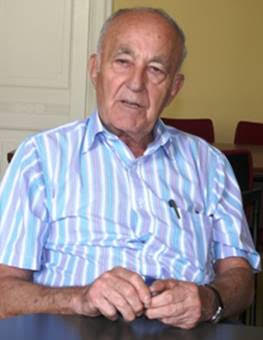
THE VOICE OF INTERNATIONAL LITHUANIA
|
VilNews has its own Google archive! Type a word in the above search box to find any article.
You can also follow us on Facebook. We have two different pages. Click to open and join.
|
Food, wine and more
- Posted by - (0) Comment
Lithuanian food traditions
since the Grand Dukes
Prie lietuvių stalo – at the Lithuanian table
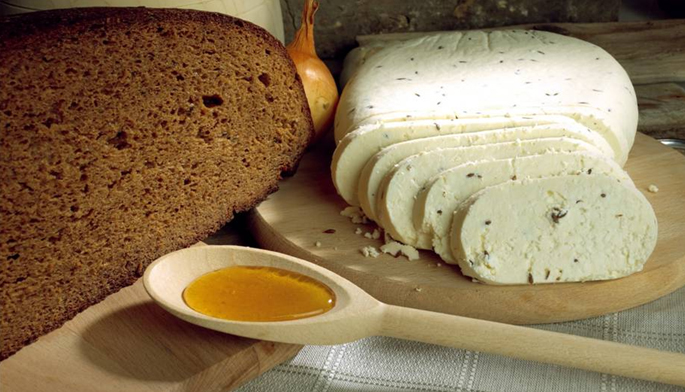
Text: Vin Karnila
Sveiki garbingi skaitytojai,
Lithuania is steeped in traditions. It would be difficult to think of any part of daily life, family events or holidays where age old traditions are not practiced. Included in these are the time honored traditions that are practiced at the table. Yes, even sitting at the table to enjoy your meal is something that involves traditions practiced for generations by Lithuanian people all over the world.
To start, there is the order of seating. The father sits at the end of the table. Now the end he sits at is important to note also. He sits at the end of the table that is near the wall not the end that faces the open room or the door. The eldest son sits at the father's right, while the other men sit next to the son along the wall. Women sit across from the men and the mother sits at the opposite end from the father. This traditional seating is maintained especially during holidays, when the entire family gathers together.
Now the question arises about the seating when the grandparents are at the table also. In this case it is customary that the father of the man of the house would take the position at the end of the table near the wall and his son (the man of the house) would then sit to his right.
Here is another tradition that I still see happening regularly. This involves an unmarried lady regardless of her age. She can be four or forty four it doesn’t matter. Very often at big get-togethers the hosts need to borrow tables, chairs and benches to accommodate all the guests. As a result the seating can be a little cramped, which is really no problem and adds to the friendship of the occasion. What happens is one of the little girls will want to sit at the table so she will squeeze her way onto the end of a bench at the corner of the table. Upon seeing this, the married ladies will throw their hands up in the air and shriek in horror. There is then a mad scramble and this confused little girl will be thrown between two of the married ladies and a married lady will take the place at the corner of the table. The by now very confused little girl will sit there with a very perplexed look on her face trying to figure out what the big problem was. It is then explained to her that if an unmarried lady sits at the corner of a table she will be cursed and never will marry. As I said, I see this happening to this day. To see the whole thing unfold can be quite entertaining.
With all the wonderful food that has been prepared, still the most important of all is the Bread. For Lithuanians bread is the most important of all food. It is a part of Lithuanian tradition and culture and is a symbol of life itself. This is why the Bread is placed in the most honorable place on the table which is right in front of father. The meal starts with the slicing of Bread by the father and this is done following tradition.
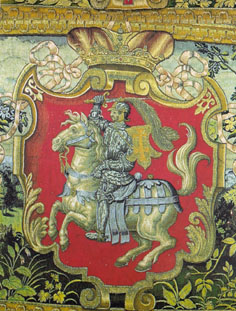
Father slices and passes the bread with great respect. The first slice, a corner of the bread is given to the eldest, married son, with wishes that his firstborn will be a son. Each member of the family takes a slice of bread directly from father's hand and places it respectfully on the table. Notice that the tradition is that the father takes the bread in his hand and places it in the hand of the others. While passing food to others at the table with your hands in some corners of social etiquette would draw gasps of table manners’ shock, for Lithuanians this is a symbol of great respect and love. The father is passing the bread, the symbol of life, from his hand to yours. I don’t mind telling you and I am not embarrassed to say that every time I sit at a table and watch this symbolic gesture take place I am almost overcome with emotion. It is truly one of the most beautiful of traditions in its symbolism.
The remaining, unsliced piece of bread remains on the table, with the cut end facing the most important corner of the house (whatever corner the family feels is the most important corner) or is facing the sun. The cut end of the bread was not placed facing the door because it was believed that this would make the bread angry. I must say that no one has ever explained to me exactly what would happen if the bread got angry about having its cut end pointed at the door but considering the importance bread plays in Lithuanian traditions and our daily lives it’s best we point it in the correct direction so we don’t find out.
This next tradition concerning bread is absolutely essential to abide by.
The bread IS NOT to be placed upside down on the table. I can guarantee that if you do this YOU WILL hear about it. The reason being is that placing bread upside down on the table is a serious desecration and for that the bread's vengeance will appear as a death in the family.
Another important tradition for the respectful handling of bread is that it is not allowed to break a slice with one hand. It takes both hands to earn bread so also it should be broken with two hands.
This tradition works great to get the kids to practice better table manners and handle their food more carefully. If you drop a piece of bread on the floor you must pick it up off the floor, kiss it and then eat it. It doesn’t matter how big or small the piece is, this tradition must be followed. Oh yes, I remember this one. This was probably the number one thing that got me to use better manners at the table.
Now one more piece of advice regarding bread at the table. How many of us have used a small piece of bread to mop up some of the remaining gravy or sauce off our plate? I openly confess to this practice and it’s a very practical and tasty way to enjoy the remaining sauce and at the same time you are helping clean the dishes. In fact one of the pleasant parts of sitting down to enjoy a wonderful Italian pasta dinner is using a piece of fresh and oh so delicious Italian bread to get every last drop of tasty tomato sauce. Growing up in a mostly Italian neighborhood I can tell you that this is common practice and is accepted and even encouraged. However when you are seated at a Lithuanian table, bread is never and I repeat NEVER used to clean up sauce off the plate. Weather you hold the bread in your hand to do it or break off a small piece and then use your fork, bread is not a tool to clean your plate and bread is not an eating utensil. The tradition is that bread is eaten from your hand and is the practice that should be followed at the table.
Should a visitor arrive when the family is at table, the visitor greets the eaters
with "skanaus" (bon appétit). If father answers "prašom" (you are welcome), it means do join us at the table. However if the answer is "ačiū" (thank you), the visitor is not invited to join in the eating. If invited to join the family at the table, a visitor from far away is either seated next to father or in his place. A “beggar” is seated at the other end of the table, near the door. Please allow me to add something to this. If you are visiting a Lithuanian family, that still follows traditions, and you are invited to sit at the father’s place, you are being paid a great honor. Be sure you thank your hosts most graciously.
Now here comes another Lithuanian tradition – The tradition of accepting or declining. When offered something you MUST at first politely decline. To accept at the first offering is considered extremely rude. The host MUST then ask offer again. For the host to not offer a second time is considered extremely rude. You should then again politely decline the second offer. The host should then offer again for a third time. After the third offer you can then graciously accept. If after the third offer you still politely decline then it is accepted that you really do not and/or can not accept the offer. Hence the tradition of asking three times.
An unexpected visitor was always graciously received and even if the family was not prepared to eat yet, food was soon set out. It usually consisted of traditional sausages, curd cheese, honey, eggs and homemade beer. To be polite, the visitor did not eat or drink until the host urged him to do so. This urging, when done immediately after the food and drink are put on the table, is a true sign of Lithuanian hospitality.
If the table is loaded with all kinds of goodies but there is no urging to partake in the food, it is said, "there was plenty of everything, but there was no urging at all from the host".
In earlier times, the host would fill his glass with beer or mead, and greet guests with these words,
"to your health dear brothers, drink and be merry. Be healthy, dear visitors". He then sprinkled a few drops on the floor so that everyone would be in good health and then drank from his glass. The spilling of a few drops of your drink is actually done as a “gift to the gods” (of drink). Refilling his glass again he would then pass it to the guest. If everyone shared the same glass, each one greeted each other with these words, "be healthy", and answered with "to your health". The glass was sent around the table from the right side because spring seeding was done with grain sprinkled to the right side, so drinks also go to that side. This tradition still continues today.
Lithuanians are known for their hospitality. They like to entertain and be entertained. Expecting guests they go all out preparing all kinds and amounts of delicacies. The hosts appreciate this statement, "there was plenty of everything, the only thing missing was bird's milk".
Guests preparing to go, thank, saying "thank you for the delicious cake, strong beer. Today we ate and drank yours, next time we'll drink mine". The host answers, "to your health".
There is another belief that the family cat, when she washes her face with her paw is telling you that guests are coming. The guests will come from the direction to which the cat is facing. Another arrival is forecast by cutlery falling on the floor, if a knife or spoon falls, a male guest is on his way, if a fork falls, expect a female guest.
So the next time you are invited to sit at the table of Lithuanians, take a moment to observe how many of these traditions are still being followed. Or – Maybe you can add some of them to your table?
- Bookmark :
- Digg
- del.icio.us
- Stumbleupon
- Redit it
- Posted by - (7) Comment
Our moms’
Lithuanian recipes

Our moms’ Lithuanian recipes is on Facebook. Click HERE to find it!
In 2011, a few of first generation Lithuanians from the Hartford Connecticut area in USA started posting on internet that they'd like to share some recipes that they grew up with. Many of these recipes may have been stored in someone's head and not written down, and the group wanted to make these recipes and food history from their beloved homeland at the Baltic Sea available also for future generations.
The group’s vibrant Facebook Page has till now collected over 1,000 members!
The people behind the page is very interested in recipes that they can share with all interested in their Lithuanian background. Even if the old written recipes aren't legible anymore, you are asked to post photos of them. They will help you decipher or translate them, and get them posted so all can all enjoy them!
If you remember eating something Lithuanian as a kid and can't remember what it's called, post a description of it. Someone will likely know what it is and can post the recipe.
If you don't have recipes to post, join the Group and enjoy the cuisine and discussions. Try making something and let them know how it came out. They will also help you with trouble shooting.
Many of these recipes differ from family to family, so it is very interesting to see more than one post of the same recipe.
|
|
Our Moms’ Lithuanian Recipes was started by Ellen Petkaitis Carmichael (1961-2011) Ellen Petkaitis Carmichael was the driving force behind Our Moms' Lithuanian Recipes. Sadly, she died in a traffic accident just months after she started this success page, which now collects food-interested people with Lithuanian origin worldwide. We reproduce below the letter she wrote to VilNews when she introduced the Facebook Page in early 2011.
|
|
Ellen was born on December 21, 1961, Manchester, Connecticut, USA. She lived in West Hartford, Connecticut. Rest in peace, dear Ellen, you did a tremendous job for Lithuanian heritage!
|
|
Written by Ellen Carmichael in April 2011
ALL LITHUANIAN FOOD LOVERS FROM EVERYWHERE ARE WELCOME!
I remember my young days standing in my mother Ramute and aunt Danuteʼs kitchens watching them cook the food they had grown up with in Lithuania. Always busy, rushing around with purpose. Interesting, that they never had any cookbooks! It was always “a little of this, and a little of that”. But it always came out delicious. It wasnʼt until years later that I became interested in cooking the cuisine myself. When I asked my mother for her recipes, she said they are all in her head. So I started to write things down as she was cooking, and was later able to sit down with her and pick those recipes out of her brain and put them down on paper. Still, pinning her down on exact amounts of ingredients was a challenge. Interestingly, even though my Aunt Danute and my mother were sisters, their cooking was slightly different. Was it because neither of them wrote how they cooked things down; thus changes inevitably evolved? Probably. Iʼve noticed that as people post recipes for the same food in OMLR, they are all slightly different, but have the same basic ingredients. Thatʼs why I encourage people to post their recipes even if a recipe for that particular dish is already posted.
Where are all the Lithuanian Recipes?
I was curious why there arenʼt a larger number of Lithuanian cookbooks written in English. Certainly not nearly as many as for other foreign cuisines. It then occurred to me. For example, many of the Lithuanian immigrants came to the US during hard times, such as during the second world war. They escaped from Lithuania with only the clothes on their backs and the meager supplies they could carry. I think cookbooks were not a priority when they had to leave. My mother confirmed that was the case when she left Lithuania in 1942. They were almost trapped in the bombing and the fighting that took place between the Germans and the Russians and were forced to leave on foot. They lived on potatoes, onions and whatever farmers gave them while on the run into Germany. They certainly learned how to be creative with potatoes. When
finally in the United States, English was not their first language,
so if they did write some things down, it was in Lithuanian.
How OMLR got started
My cousin Paul posted onto his Facebook page a wonderful picture he found on the internet while searching for various Lithuanian recipes, and he commented: “Blogging about her Kugelis recipe no doubt”. That Facebook conversation turned into one where we reminisced about some of the stuff we ate as kids and I asked Paul if he has some of his mother’s (Danute’s) recipes, and he said not in electronic form. Then Paul’s friend Vida posted that she’d like to get some of Danute’s recipes too. Cepelinai, Napoleonas Tortas, koldunai, bacon buns were reminisced about in that thread. Vida suggested we start a FB page; I volunteered and got it started right away, using Paul’s posted picture as the profile picture. I wish I could give someone credit for that photo, but I have no idea where it came from and couldn’t find it again on the internet. I expected ten, maybe fifteen members to join. Pretty much only people that knew us. But much to my delight, it’s growing and there are members from all over...Australia, Switzerland, Lithuania, Canada, UK, all over the USA and probably more.
Troubleshooting with others
One thing that makes this site unique and especially useful for Lithuanian recipes, which do vary so much from person to person, recipe to recipe, is that we have an active dialogue going on about the nuances in the preparation. We also trouble shoot when things don’t go as expected. For example....”Why did my Cepelinai fall apart when I boiled them???” Group members chime in and offer their experience. You just don’t get that with a traditional recipe book. Lithuanians certainly are passionate about their food. It really comes out on this interactive site.
Several members posted that they remember eating something when they were young…something that their Lithuanian grandmother or relative made…but couldn’t remember what it was called, so they couldn’t find it on the internet. They described on their post what they remember about it. Group members gave suggestions as to what it could be and posted their own recipes for it.
The other thing that came out of it is this: I asked one of the members a question on her message board (not as a post) and we've been communicating ever since. She was born in Lithuania, moved to Germany at 19 and now lives in Switzerland. It's amazing how food can connect people that normally would never meet! Having a Lithuanian interactive food site is especially great, considering the passion Lithuanians have for their food. I don't want to make it sound like a great place to meet people... That's not the purpose for the group[!! It was just a nice result that came from it.
Finally, I think one of the most interesting thing I've come to realize in doing this, is that Lithuanians really don't write their recipes down in general. I've heard over and over again that they are stored in their mother's or grandmother's heads...a common phrase is "a little of this and a little of that" when asked how much of the ingredients go into a given recipe. So I suggested that one of the reasons for that is perhaps many of the Lithuanians emigrated out of Lithuania with only what they could carry. No room for cookbooks. Many were on the road for months, even years before they settled down, so the recipes became ingrained in their heads and there was no reason to write them down. That's only my idea, but it is an interesting thing for a food historian to ponder!
- Bookmark :
- Digg
- del.icio.us
- Stumbleupon
- Redit it
Two Lithuanian dishes you simply have to try!
- Posted by - (11) Comment
|
|
|
So often we hear something like this from people “I remember Sundays when I was a child. My mom would make cepelinai (potato dumplings filled with meat) and we would all gather around in the kitchen for this special meal”. Sadly what we also hear is “I have no idea how to make these traditional Lithuanian foods”.
So, for those of you wanting to experience “true Lithuania” and wanting to remember the “good old days,” a few culinary musts are CEPELINAI, KUGELIS (potato pudding/cake) and ŠALTIBARŠČIAI (cold beetroot soup), accompanied of course by a glass of cold beer. Preferably Lithuanian beer.
Today we bring you the recipes for the šaltibarščiai and the cepelinai.
Now before I get into the recipes, it may be a good idea to explain why I was chosen to write this and other articles about preparing traditional Lithuanian food. I am not what you would call a great cook. With the exception of some amazing creativity with a barbecue, in the kitchen if I somehow prepare a marvelous meal it’s more a matter of luck rather than any amount of skill.
Some of the recipes may seem to be a little involved but actually they are not. All of the recipes I will give you are for meals I have prepared myself and I don’t mind one single bit telling you that they came out great!!! So the decision was made that if some one like me who needs to be supervised while in the kitchen so I don’t hurt myself can prepare these meals with success then I would be the best person to share these recipes with our dear readers. I’m sure that all of you will also meet with success when you prepare these traditional foods of Lithuania. After all, if I can do it...
ŠALTIBARŠČIAI
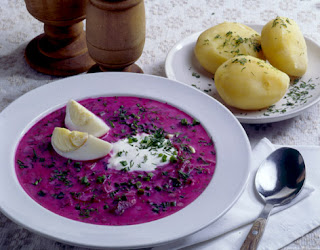
Here is what you will need:
2 good sized Beets
2 Cucumbers about 6 inches/15cm long (the smaller ones have more taste)
Sour cream
1 Liter/4 cups Sour Milk or Butter Milk
1 cup Boiled Water
8 sprigs of Fresh Dill – Finely Chopped
250 ml./1 Cup Scallion Greens or Chives - Finely Chopped
Salt and Pepper to taste
INITIAL PREPARATION:
Boil the beets for about 30 minutes.
After the beets cool enough so that they are comfortable to touch, peel off the skin.
Cut the beets into very thin strips – about 1/8 to 1/4 of an inch wide and 2 inches long. This can be a little time consuming so some people will coarsely grate them instead.
Hard boil the 2 eggs and allow to cool completely
Boil the 1 cup of water and then chill it (it should be COLD)
Finely slice the cucumbers
Crush the egg yokes
PREPARATION:
Add everything together. Add the Beets, Cucumbers, Milk, Scallion Greens/Chives, Boiled Water that is now Chilled, 100 gr./6 Tablespoons of Sour Cream, Salt and Pepper to taste and mix well.
Serve in individual bowls sprinkled with the Dill. The Egg Whites can be finely chopped and added to the mixture or you can get a little creative and finely slice them and put on the soup for decoration.
Traditionally ŠALTIBARŠČIAI is served with hot boiled potatoes as a side dish.
And don‘t forget the Lithuanian Black Bread
CEPELINAI
Recipes for traditional foods for all nationalities will all have their little “twists“ added in based on the region of the country or from one family to another. The recipes for many traditional Lithuanian foods are the same. The recipe for Cepelinai is like this. Based on what region your family is from or how your grandmother preferred to make them, you will find a difference with the amount of raw grated potatoes and boiled potatoes used.
The next question is what kind of potatoes should be used???
It’s best to use what is considered a “white” potato.
OK OK OK – now before some one says – What a moron this guy is, ALL potatoes are WHITE please allow me to elaborate :o)
As an example, don’t use Red potatoes and there is a variety called Yukon Gold which will give you an OK constancy but the color will have a strange yellow tint to it. I’ll need my friends in California to help me out on this one – Hey Sig and Rima, I understand that out on the West Coast there is a variety of potato that’s PURPLE??? Could you shed some light on this please? What works best are U.S. varieties such as Idaho and Maine potatoes. Our good friends in Canada have those wonderful P.E.I spuds and russet potatoes from your Prairie Provinces will work just fine. Here in Lithuania and Eastern Europe I honestly don’t know what the variety of potato is called here. I just use the potatoes that are not the Red potatoes (now you can maybe start to understand why I need supervision while I’m in the kitchen so I don’t hurt myself).
Here is the basic ratio for Grated to Cooked potatoes – For every pound/.5 Kg. of Potatoes use 2 average size Potatoes for the Cooked Potatoes.
POTATO PREPARATION
Peel 5 Lbs. of potatoes
Boil 8 average size potatoes
Grate the rest of the potatoes (apx. 4 Lbs.). When you grate the potatoes you need to use the side of the hand grater that has the SMALLEST holes if you want to get the correct constancy
In workable portions, place the grated potatoes in a doubled cheese cloth and squeeze dry.
Squeeze the liquid into a pan and let potato starch settle to the bottom. Carefully pour out the potato liquid and add the potato starch back into the grated potatoes.
Once the boiled potatoes have cooled a bit, put them into a ricer and then add to the grated potatoes and mix well. If you don’t have a ricer (I don’t) you can mash the boiled potatoes up with a potato masher and then add them to the grated potatoes and then mix VERY well. During the mixing add salt to taste.
MEAT STUFFING
The amount of meat depends on how much you use to fill each Cepelinas. It’s better to have some meat left over than run out so you may want to start with at least 600 gr./1.3 Lbs. of ground Pork.
Fry up a finely chopped onion and then add the ground pork and 2 teaspoons of Marjoram and cook until done. I may add that there is a spice mix called “Maltos Mėsos Prieskoniai” (Ground/Minced Meat Spices) that is sold in Lithuania and can be found in practically every kitchen in the country. It’s a blend of spices traditionally used in ground meat dishes including Celpelinai. It can be purchased at www.BalticValue.com
MAKING THE CEPELINAI
The amount of Potato and the amount of Meat used for each Cepelinas is something you just kind of figure out for yourself but to start with take about a half cup of the Potato mix (baseball/cricket ball size) and flatten it out. When you flatten it out it should be apx. a 6 inch/15 cm. circle ½ inch/1 cm. thick. Place 1-2 spoonfuls of the Meat filling in the center (apx. 1 inch/2 ½ cm. thick) and then roll the Potato mix around it and seal the edges and form into a small football (American football)/rugby ball. For me this is the most difficult part, trying to figure out how much Potato mix, how much Meat and then forming it all together but after 2-3 you get the hang of it.
Carefully put each Cepelinas into a large pot of salted boiling water. Some people put a spoonful of corn starch into the water to help keep the Cepelinai from falling apart. Boil 30 minutes and enjoy.
For toppings, some people enjoy a sauce made of fried bacon pieces and some enjoy Their Cepelinai with sour cream.
If this all sounds a little complex it really isn’t. It’s quite an easy meal to prepare. The most time consuming part is grating all the potatoes. In fact even with the people that are familiar with making dishes like Cepelinai and Kugelis that require A LOT of grated potatoes the reason they say that they don’t make these dishes more often is that it just takes so long to grate the potatoes.
Well a Lithuanian company has come to the rescue! There are a lot of kitchen machines on the market that do a lot of things but none of them actually grate potatoes to the consistency required for dishes like Cepelinai, Kugelis and Potato Pancakes to name a few. It figures that a Lithuanian company would understand what a machine needs to do to grate potatoes to the correct consistency. This machine which is known as the “Electric Potato Grater” has become an extremely popular item here in Lithuania because it is FAST!!! You can grate 10 Lbs/5 kg. of potatoes in minutes. For more information about this Electric Potato Grater you can go to www.BalticValue.com They have the machine in BOTH the 110 Volt and 220 Volt models and they ship all over the world.
Enjoy your Šaltibarščiai and enjoy your Cepelinai.
The next recipe will be for one of my personal favorites KUGELIS!!!
Skanaus – Vin Karnila
- Bookmark :
- Digg
- del.icio.us
- Stumbleupon
- Redit it
A beer drinking country
- Posted by - (12) Comment

There are a number of things that make any Lithuanian swell with pride;
Rich History, Amber, Beautiful Nature, Basketball, etc.
There is, though, one that has a special place in their hearts. This source of pride is the Lithuanian Beer. Today, Lithuanians are among the best beer producers in the world, enjoying numerous international awards for the subtle taste and high quality of their drink. But is beer a truly “Lithuanian” drink and how deep are the traditions of brewing beer in Lithuania?
- Bookmark :
- Digg
- del.icio.us
- Stumbleupon
- Redit it

A story from the page Juozo
philosophy
http://www.hbhjuozas.lt/?en=1103006956
This is one more area Lithuania has reason to be proud of. The Russians may disagree, as they claim to have started producing vodka in the 17th century. Lithuanians, however, claim that the Russians didn’t know how to make real vodka until the Russian chemist D. Mendeleev (1834-1907) discovered the process of the rectification of the alcohol. He also was the first, who suggested mixing alcohol and water according to the weight, and not volume, something not known to the manufacturers of the poor vodkas in Western Europe up till today.
In the old times, before this discovery, Russian villagers had a soured drink - "sivuha", "samagon", "brandahlist". The Ukrainians in the 17th century tried to learn how to distil vodka from the Lithuanians, but having no experience they distilled a whitish drink "gorilka", that kept all the alcohols and the water steam inside, and which contained about 25-30 per cent of alcohol. Most probably it was cheaper to buy vodka, which was brought by the Lithuanian merchants, than to make it. Knowledge and experience were needed for this.

BUT
In
Lithuania vodka, distilled from grain, was already being made at the beginning
of the millennium, just after year 1000!! A sour drink "gira", beer
and mead was made, but vodka was being distilled. The specially prepared barley
was being burnt (heated) so it by no means was boiled, but the vodka
evaporated. From this process vodka gets its Lithuanian name -
"DEGTINE" which comes from the verb “degti” (to burn). By the way,
this is the only term, describing the process of the production of the strong
drink. This linguistic-semantic argument is the most archaic in the world.
Whisky - means "water" in old English, eau de vie - "water"
in old French, vodka - "water" with a little bit negative meaning in
old common folk Russian. Ancient Lithuanians in their experience knew that
ethyl alcohol evaporates at the temperature of 78.3 degrees. Even now the very
good distillers of the home-made vodka determine and control the time of the
barley burning (heating), in order to get a “clear as a tear” home-made vodka,
without any additional smells (of other alcohols), dashes, and with the alcohol
percentage of 60-70. But vodka distillers knew that while distilling vodka, the
poisonous methyl alcohol exudes earlier at the temperature of 71 degrees. The
technologists of the modern vodka production, especially from Russia and
Europe, can not understand how Lithuanians could rectificate vodka, as the
rectification process itself was not known to the world yet.
It was a taboo for the distillers to drink the first dipper of vodka, which had to be, and still has to, be sacrificed to the gods by pouring vodka on the ground. This custom is still alive and obligatory in Lithuania. The first dipper of vodka can not be drunk. It is being poured over the shoulder, simultaneously saying "For Gods!" Up till now, in the villages of the Lowlands, You can hear the distillers saying in the Lowlandish dialect: "Give the first cup to the gods"; "Who does not give to gods, gets his eyes dripped"; "First cheers to gods, then to a person"; "First cheer the god, then god will give you health"; "Pour the first vodka to gods, if you do not do this, they will take your health away."
The most famous Irish and Scottish whiskey (whisky) manufacturers are deprived of speech when they hear such an elementary rectification dictated and learned by practice and experience. They incline their heads low, and award the Lithuanians with all the laurels. While the Irish, the first to start making whiskey in the British Isles, come straight to the point. They say that the beginning of whiskey and beer production, in the 13th century, was not spontaneous. It was started using the recipe, originally brought from somewhere, most probably from Lithuania.
"Trejos Devynerios"("Triple Nine") - the oldest bitter in the world

"Trejos Devynerios" is the bitter of 27 (9+9+9=27) herbs. In the old times it was made right after St. John’s night, at the sunrise. The herbs were collected in a way, known only to the priests (earlier - to the senior priests). Then the herbs were conformably dried, specially put together and infused with vodka (60% of alcohol) and distilled at that shortest night of the year. Only the priests could know the proportions. The ritual was always performed outside, for the bitter had to get the power and energy of the Sun. After the sun set, the bitter was poured into hornbeam barrels. Later on the barrels were poured over with the melted beeswax and buried in holes dug into the ground of the cellars. There the hermetically sealed bitter was kept for three years, three months, and three weeks.
In the 13-17th centuries, Lithuania was one of the biggest and the greatest countries in Europe, with its territory stretching from the Baltic till the Black Sea (including the present Belorussia, Ukraine, and Western Russia). The Grand Lithuanian Principality was often at war protecting Europe from the Tatar-Mongol hordes from the East. In the 13-17th centuries, having the most modern armaments in Europe, using the latest war tactics and strategies founded by the talented Lithuanian commanders, Lithuanians beat the Army of Batijus, and stopped their invasion into the Europe. Also for those long ages Lithuanians were fighting with the aggressive crusaders and sword bearing orders, holding off the onslaught of Lithuania from the West. The Lithuanian knights and warriors were using "Trejos Devynerios" as a universal remedy from cold and joint illnesses, as a disinfectant and a treatment means for war wounds, and also as a tonic for prophylactic. For Lithuanian men the greater part of their lives were spent in wars, so the healing bitter "Trejos Devynerios" was even included into the army list of food supplies from what is shown in the old Lithuanian army’s supply lists of the 15th century.
Six centuries later, in 1878, "Trejos Devynerios" showed up in the small German town of Welfenbüttel, just with a different name - "Jegermeister." After the German taste, it was much sweeter, but still there was a note on the label, that the recipe was received from Lithuanian monasteries. But when "Jegermeister" became famous in the rest of the world, the note, that the drink was being made according to the Lithuanian recipe, was not on the label any more. Anyway, there is still "Kreuter Mieke" in Germany. It is made out of herbs and it is used in the production of "Jegermeister." On the label of "Kreuter Mieke" there is a note stating that this is a mixture of 27 herbs after the original recipe of an old Lithuanian monastery.
In 1511, The Grand Duke of Lithuania Zygimantas the Senior allowed the merchants of Vilnius to buy and sell as much grain as they wanted freely, because a lot of grain was being used in the production of vodka, beer, and "gira" (a sour drink). Even the Guild of the Malters of Vilnius was founded. This guild sprouted, dried and ground the grain coarsely and sold it to everyone who wanted to make vodka and beer. This was legal, because during the period of the Grand Principality of Lithuania every inhabitant of Lithuania had a right to make mead or beer and to distil vodka for their own needs
The best homemade vodka from grain is believed to be distilled in the Lowlands in the Plunge district, and from rye - in Dzukija in the Varenos district and around Labanor. Officially this homemade vodka "Samane" is being produced by Alytus "Alita." This company is the only one in the world which does this.
"Starka" - thousand years old and probably a better drink than whisky

"Starka" is special festal vodka, which was traditionally made on the day of the birth of the first son. Already in the 15th century the foreigners, who were visiting Lithuania and describing its life, noticed the fact that when the midwife announced the birth of the son, men started distilling vodka. Later they poured that vodka into the oak barrel, which was later coated with the hot beeswax and dug into the ground. The barrel was being dug up, and the liquid tasted on the wedding day of that son, that means, at least about 20 years later. The name of this vodka is purely Lithuanian. It comes from the old Lithuanian word "starkus" (a stork), and this is connected with the widely spread story, that the new baby is being brought by the stork. And up to now countrymen are asking not for "Starka", but for "Starkine" vodka at the shop.
Though Russians are trying to explain that "starka" has come from the Russian word "staraya" (meaning "the old one"), if so the name of the vodka would be "Staraya", because, since the Russians learned to distil the potato-grain vodka after opening "Smirnoff" vodka factory, all Russian vodkas still have their original names: "Listovka", "Dovgan", "Spotykach", "Yerofeych", "Staromoskovskaya" and from Soviet times - "Moskovskaya", "Stolychnaya", "Russkaya", "Kubanskaya", "Sibirskaya.". In addition, from the linguistic side, the word "starka" has no semantic meaning in Russian.
Lithuanian mead is one of the oldest strong drinks in the world
Nowadays the only factory in the world "Lietuviskas midus" ("Lithuanian mead"), which is in a small Lithuanian town Stakliskes, produces Lithuanian mead of various kinds, according to recipes that are thousands of years old. Also here the especially strong and aromatic mead bitters (balsams) "Zalgiris" (70%), "Nemunas" (60%), "Suktinis" (50%), seasoned with herbs, are being made. These drinks are not only the most ancient of drinks with unique peculiarity in the whole world, they are peculiar only to Lithuania, and they could make Lithuania even more famous than for basketball if the Stakliskes folks would advertise themselves internationally.
Lithuanian "Krupnikas" - the most noble liqueur in Europe

This is the liqueur from honey and herbs, that was made by the monks of the Bernardine monastery, which was settled in Nesvyzius by M.K. Radvila Naslaitelis. The monks could see wine only on the tables of the dukes and the aristocracy.
In 1546, the wine cellars were built and equipped on Tiltu street in Vilnius. The wine supervisors had a home nearby. By the way, the costs of transporting the wine from Hungary made up to 65.3% of the wine’s price. The percentage was even higher, when the wine was brought from Avignon, or any other region of France, Southern German principalities, Italy - the Kingdom of Naples, Lombardy, Toscana, or the Pope’s wineries. Much wine was brought by the Hanza merchants. This wine was mostly being bought by the wine supervisors of the Vilnius’s Royal Palace. So, it goes without saying, that wine was being drunk only by the rich. The Bernardine monks, who came from the Southern parts of the Europe, were especially fascinated by mead - a not very strong drink, having the taste and aroma of the natural honey. On the base of this drink Bernardines created "Krupnikas." For the first time, the guests were officially treated to "Krupnikas"in 1593, on the occasion of the building of the NesvyZius Radvilos’ palace. This date should be considered the official date of the origin of Krupnikas. Of course, this date can not be related neither with the that is being made by "Vilniaus Degtine", nor with the drink of Kaunas’s "Stumbras." The real recipe of Krupnikas, which was created by the Bernardines, is different. It was known to the author, just as the other recipes of the ancient Lithuanian drinks. The author would agree to teach the recipe only to the Lithuanian Bernardines or the Kretinga Minorites because they had especially well conditions to make Krupnikas, but in no way he would teach the state or private companies.
The honey liqueur Krupnikas soon became the favourite drink of the aristocracy, and especially ladies liked it. Krupnikas became most famous after the 1920s, when Lithuanian independence was restored and when it became the most popular drink among the aristocrats of Kaunas. It was being served at feasts of the highest rank and governmental balls. At the Presidency and institutions, in the parsonages and estates, Krupnikas was being served in tiny, cut-glass decanters and drank from cups of the size of a thimble. It was drunk together with the coffee. Very often the estates, parsonages, and even the wealthier homes were making Krupnikas according to their own recipe. Krupnikas was being made out of everything at that time: cherry and lemon, orange and tangerine, badyan (a kind of anise) and cardamom, wine and champagne, montpensieur and brown sugar, but these were only primitive imitations that had nothing in common with the real Krupnikas.
At the same time the Polish started making their own "Krupnikas", but it was far from the original one. However, the Polish were justifiably proud of it. Because of this, some Lithuanians think that Krupnikas was created by the Polish in 1930.
Just do not forget that Lithuanian Krupnikas is the only liqueur in the world that is being warmed up before drinking. This is the way it was drunk by the monks and the nobles and only tasting krupnikas in this way can the marvellous, perfectly tuned honey, grain, alcohol and herbs taste and unique aroma open.
- Bookmark :
- Digg
- del.icio.us
- Stumbleupon
- Redit it

Photo by Yours For Good Fermentables
I’m very excited to share this recipe with you because
KUGELIS IS MY ABSOLUTE FAVOURITE
Once again I have been elected to share a traditional Lithuanian recipe with you due to the fact that I am so very “culinary challenged”. Please remember that I need to be supervised when I’m in the kitchen so that I don’t hurt myself. But the powers to be of VilNews feel that I’m the best person to share these recipes since if a person with my limited cooking skills can cook these tasty meals than it shows to every one how easy they are to prepare.
- Bookmark :
- Digg
- del.icio.us
- Stumbleupon
- Redit it
- Posted by - (9) Comment
Time for ŠAŠLYKAI,
the Lithuanian barbeque
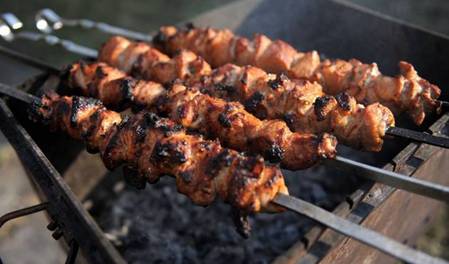
Dark grey days and cold nights are soon here again as autumn is making its way back to Lithuania. The summer season is coming to an end, but the early autumn sunshine will still be very much welcomed, somewhere in nature or in a garden, where the people of Lithuania still will be enjoying the typical early autumn sun with a tasty, warming šašlykai prepared over the charcols.
Šašlykai or Shashlik is a form of Shish kebab popular throughout the former Soviet Union, Eastern Europe, Pakistan, Mongolia, Iran and Israel among other places. Shashlik (meaning skewered meat) was originally made of lamb (in some extent pork or beef) depending on local preferences and religious observances. These skewers of meat are either all meat, all fat, or alternating pieces of meat, fat, and vegetables such as bell pepper, onion, mushroom and tomato.
Meat for shashlyk (as opposed to other forms of shish kebab) is usually marinated overnight in a high-acidity marinade like vinegar, dry wine or sour fruit/vegetable juice with the addition of herbs and spices. While it is not unusual to see shashlik listed on the menu of restaurants, it is more commonly sold in Western Asia by street vendors who roast the skewers over wood, charcoal, or coal. Shashlik is usually cooked on a grill called a mangal.
- Bookmark :
- Digg
- del.icio.us
- Stumbleupon
- Redit it
Ready for a mushroom hunt?
- Posted by - (4) Comment
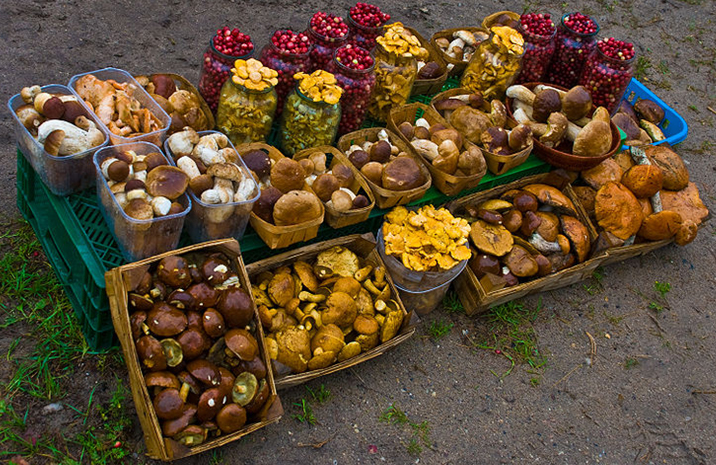
Mushroom ‘outlet’ at a Varena roadside.
Mushroom picking is undoubtedly one of the favourite activities of the Lithuanian people. It starts in the spring and lasts till the first frosts, normally early November. Mushroom hunting is probably Lithuania’s second most popular sport, after basketball. When rumours start to float around that the first mushrooms of the year have been seen in the woods, people get up at 6 am on Saturday morning and go to the woods with their baskets and plastic bags. You can actually experience traffic jams at that time on a Saturday morning! Entire families go mushrooming and return with overflowing baskets.
The most abundant forests are in Dzukija, the south eastern region. Traditionally the inhabitants of this part of the country are the most prolific mushroom gatherers and this region's cooks are known for the most creative mushroom recipes. The mushroom capital of Lithuania is the town Varena, founded in 1862 as centre of the Varena District. Due to lower harvests in infertile soil, local farmers had to supplement their yields with edible mushrooms and berries collected in the forests. Still today mushroom collecting remains an important part of the local economy.
All over Lithuania mushrooms are used in many dishes, to add special flavor to meat, fish and potato dishes. Mushrooms are used fresh, dried, salted or marinated. More than four hundred edible varieties are found in the Lithuanian forests. The most popular are boletes. Also collected are chanterelles, blevits, morels and many others.
Mushroom recipes from the book LITHIANIAN TRADIONAL FOOD
Compiled by Birutë Imbrasienė
Edited and translated by Giedrė Ambrozaitienė
Keptos grybų kepurėlės
1/2 k (1 lb) fresh boletus or button mushroom caps
100 g (6 tablespoons) butter
2 tablespoons flour
salt and pepper to taste
Wash mushroom caps, blot dry and roll in flour, seasoned with salt and pepper. Fry floured mushroom caps in butter on low heat until nicely browned, about 20 minutes.
Serve with hot potatoes or bread for lunch or as a late afternoon snack.
FRIED MUSHROOMS WITH ONIONS
Kepti grybai su svogūnais
1/2 k (1 lb) fresh boletus or white or brown, mushroom caps
200 g (3/4 cup) vegetable oil
3 onions, diced
several bay leaves
pinch of salt and pepper
Drop dry mushroom caps into hot oil and fry on low heat, about 20 minutes. Add onions, seasonings and fry for 5 more minutes.
Serve warm fried mushroom caps with hot potatoes and cold caps with toasted black bread.
MUSHROOMS SIMMERED IN SOUR CREAM OR MILK
Grybai troškinti grietinėje ar piene
1/2 k (1 lb) fresh mushrooms
100 g (6 tablespoons) butter
2 onions, finely chopped
4 tablespoons sour cream or 1 cup milk
salt and pepper to taste
Brush mushrooms clean. Slice and cook in a frying pan, in their own juices. Cook until all liquid evaporates. Add butter and onion to mushrooms, bake for 15 minutes. Pour sour cream or milk and simmer for 5 minutes.
Serve for lunch with hot potatoes or bread.
MUSHROOMS IN A BLANKET
Kepti grybai tešloje
1/2 k (1 lb) fresh mushrooms
100 g (3 oz) butter or vegetable oil
1 egg, beaten
2 tablespoons flour
2 tablespoons bread crumbs
pinch of salt
Brush mushrooms clean, cut in halves and dust with salted flour. Dip mushroom halves into egg and roll in bread crumbs. Fry breaded mushrooms in hot oil or butter. Place fried mushrooms on a baking sheet and bake in preheated oven at 250F/120C, for about 10 minutes.
Serve with bread or hot potatoes for breakfast, lunch or as a late afternoon snack.
CHANTERELLES WITH BACON
Voveruškos su lašiniukais
1/2 k (1 lb) fresh chanterelles
100 g (3 oz) bacon, finely cut
2 onions, finely chopped
salt and pepper to taste
Wash chanterelles and drop into salted, boiling water. Cook about 15 minutes. Fry bacon and onion, add cooked chanterelles and a pinch of salt and pepper. Cover frying pan and continue baking for 10 minutes, stirring several times.
Serve for lunch with hot potatoes.
BRAISED MUSHROOMS WITH POTATOES
Troškinti grybai su bulvėmis
10 potatoes, peeled and cubed
1 k (2 lbs) fresh mushrooms
100 g (3 oz) bacon, finely cut
2 onions, chopped
1 cup sour cream
salt and pepper to taste
Cook potatoes until soft, drain and save potato cooking water. Fry bacon and onion. Cook mushrooms in salted water for about 20 minutes. Drain and cut mushrooms into halves. Add mushrooms to fried bacon and onion mixture. Simmer for 2-3 minutes. Sprinkle with salt and pepper, add 1/4 cup potato water and simmer for 5 minutes. Pour simmered mushrooms over boiled potatoes, mix well. Pour sour cream on top just before serving for lunch.
FRIED DRIED MUSHROOMS
Kepti džiovinti grybai
100 g (3 oz) dried mushrooms
3 tablespoons flour
150 g (6 oz) butter or vegetable oil
1 cup milk
salt to taste
Soak dried mushrooms in milk for 3 hours. Blot dry and roll in salted flour. Fry in hot fat, on both sides, about 25-30 minutes.
Serve hot, covered with pan juices.
MUSHROOM PATTIES
Grybų maltinukai
1 k (2 lbs) fresh mushrooms
3 eggs
2 onions, chopped
2 tablespoons sour cream
200 g (3/4 cup) butter
1 tablespoon flour
1 cup bread crumbs
salt and pepper to taste
Cook mushrooms, drain and chop finely. Fry onion in 2 tablespoons butter. Add beaten eggs to sour cream, mix well. Add fried onion, salt, pepper, mushrooms and bread crumbs. Blend well and let set for 1/2 hour. Then form medium patties, roll patties in flour and fry in hot butter, both sides, for about 25-30 minutes.
Serve hot for lunch with hot potatoes and dill pickles.
MUSHROOM EARS
Ausytės su grybų įdaru
3 cups flour
3 eggs
water
2 cups cooked mushrooms, finely chopped
1 onion, chopped and fried
2 tablespoons butter
2 tablespoons sour cream
salt and pepper to taste
Make dough with first 3 ingredients. Roll out dough thinly and cut into squares. To make filling, add 1 beaten egg, fried onion, pinch of salt and pepper to mushrooms. Blend well. Place a spoonful of mushroom mixture, fold over into a triangle, seal edges and join corners together. Cook mushroom ears in salted water 5-7 minutes. Drain and place mushroom ears into a bowl and cover with butter cooked with sour cream.
Serve hot.
MUSHROOM STUFFED EGGS
Grybai kiaušiniuose
8 eggs
5 mushroom caps
1 cup cooked, chopped mushrooms
1 cup sour cream
100 g (6 tablespoons) butter
onion greens or scallions fresh dill
salt and pepper to taste
Hard boil 7 eggs. Peel 5 eggs and cut off tops, scoop out yolks. Fry mushroom caps in butter. Add 2 finely chopped, hard boiled eggs, 5 scooped out yolks and 1 beaten egg to chopped mushrooms. Mix well and fry mixture in butter for 10 minutes. Fill 5 eggs with mushroom mixture, cap filled eggs with fried mushroom caps. Stand eggs in a serving platter, cover with sour cream, seasoned with salt and pepper and sprinkle with chopped scallions and dill.
This is eaten as a snack or light lunch with toasted white or black bread.
MUSHROOM CAKE
Grybų tortas
1 k (2 lbs) fresh mushrooms
3 raw eggs, beaten
4 tablespoons bread crumbs
1 cup sour cream
2 onions, chopped, fried
2 hard boiled eggs, chopped
2 tablespoons flour
50 g (4 tablespoons) vegetable oil
salt and pepper to taste
Cook mushrooms, drain and blot dry, cut into small pieces. Add onion, hard boiled eggs, bread crumbs, beaten eggs, salt and pepper. Blend all ingredients well. Grease a spring form cake pan and fill with mushroom mixture, sprinkle top with flour and bake in preheated oven at 350F/180C, for about 30 minutes.
This is eaten hot and cold.
- Bookmark :
- Digg
- del.icio.us
- Stumbleupon
- Redit it

Lithuania offers a modern, international cuisine
fully on par with western Europe.
Text: Aage Myhre
Did you think that this country only offers traditional food? Think again… Today’s situation is that numerous Lithuanian restaurants follow the best world traditions of offering exceptional international cuisine, as well as a number of Lithuanian masterpieces, first-class service in surroundings of refined elegance and impeccable hospitality. Modern Lithuania’s excellent cuisine together with a high class service will leave you a memorable experience.
Let me bring you to some of my favourite international cuisine restaurants, this time unfortunately only in Vilnius!
- Bookmark :
- Digg
- del.icio.us
- Stumbleupon
- Redit it
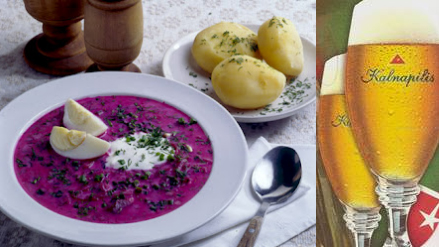
Lithuanian summer means Šaltibarščiai – cold beet root soup –
and a refreshingly cold beer!
Lithuanian summer traditions are different from what you usually find on European café tables or outdoors on a summer patio or garden. In particular, this applies to dishes Lithuanians gorge themselves with through hot summer months.
Take for example the cold beet soup, Šaltibarščiai, that you see pictured above. Take some time to read what our associate editor, Vin Karnila, writes about this and another, at least as famous Lithuanian dish....
‘Two Lithuanian dishes you simply have to try!’
To a great summer meal also belongs a refreshing cold beer. Look what Vin has to say about this foamy, beautiful Lithuanian brew...
- Bookmark :
- Digg
- del.icio.us
- Stumbleupon
- Redit it
- Posted by - (6) Comment
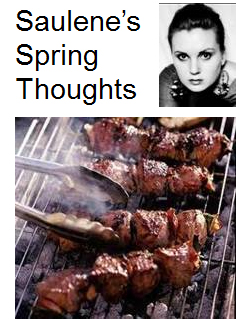
Craving for a barbeque
on a Lithuanian lakeside
Text: Saulene Valskyte
Dark gray days and cold nights are finally over and spring/summer has made its way back to Lithuania. Just a few weeks ago you still could've found some remains of snow, but now the sun made her way back and it looks that everybody became happier over night.
After a long rainy autumn and an even longer cold dark winter, people were praying for spring to come back and when it did it looks like everyone is trying to catch up on all summer activities on the very first weekend.
Lakes take the biggest role in Lithuanian summer. Over winter everyone is just craving for barbeque on a lakeside and we do make sure that the very first summery sunshine will be welcomed somewhere in nature enjoying good weather and šašlykai*. Even when the weather is still quite chilly and only dropping clues about upcoming spring fills streets with bicycles and relaxed pedestrians, it looks like for months and months people were waiting for a chance to get out of their homes and finally they get the possibility to do that. In a matter of days parks fill up with lovely couples, young families and youth playing ball, cards or just chilling on barely sprouted grass.
I work in a big shopping mall AKROPOLIS and last weekend it had its big birthday celebration with huge discounts and special offers for costumers, big prizes were up for grab, but does anyone care about it? That weekend we were rewarded with magical weather of +27 and it was so sunny, and warm breezes were flowing around so despite Lithuanians passion for shopping, everybody was commonly running from town. During that weekend lakesides were filled with people and in the mean time AKROPOLIS was almost empty.

I can’t describe the image that stuck in my head that Friday afternoon. Traffic in Ozas street, which is a huge 4 lane street, was impossible. Cars were barely moving in the direction that leads from the city centre. It looked like a massive evacuation. During the normal commuter rush hour there are half that many cars as it there was then. During all the weekend Vilnius centre was almost totally empty….
Another important thing about Lithuania and good weather is that most Lithuanians own some kind a piece of land that they use for growing vegetables or gardening. Small gardens somewhere near cities are very popular in Lithuania. People have small summer houses with only a few rooms there with a little piece of land for gardening and to escape for the weekend. Others have relatives living in the countryside. So in spring, most Lithuanians spend their time working the land and preparing it for “farming”. I find it funny when in Vilnius you can’t find friends to meet for a drink because everybody is planting potatoes.
The perfect Lithuanian evening after a hot summer day is sitting on bench somewhere in a park or on a lakeside and enjoying cold beer-we sure do love beer during the summer. So grab some friends, beer and if possible šašlykai and visit the nearest lakeside to enjoy what nature gives you and what we really do know how to apriciate.


*Šašlykai is originally an Armenian dish, but it is one of the most popular dishes during summer or any kind of camping. In Lithuania it’s usually made from pork (lamb originally). It’s small pieces of meet marinated with some vinegar, onions and some of this and that (this and that depends from the cook).

Happy Spring Days! From Saulene.
- Bookmark :
- Digg
- del.icio.us
- Stumbleupon
- Redit it
- Posted by - (3) Comment
Saulene’s
|
|

Text: Saulene Valskyte
Spring has come, the sun is shining, birds are singing, at least that's what it should be like. In Lithuania Easter weather swings from blizzard to burning sun, but regardless to that is this the most colorful celebration of the year. As all Christian celebrations Easter traditions here are intertwined with paganism, Easter in particulary were a pagan celebration of awakening nature.
The Easter celebration starts a week before Easter Day, on Palm Sunday, when people are gathering in churches with beautiful, colorful, original “palms”. In Lithuania every region have there own palm making traditions, usually palm base are the juniper twig. During the church service the palms are being blessed. Afterwards people participate in a traditional Palm Sunday ritual, beating each other with the blessed palms, wishing each other health and strength. Today this is mostly a children game, but in old days everyone were doing it, singing "It's not me, it's palm what beats you, there's Easter in a week, and you will get an Easter egg".

Just as with Christmas, the week before Easter is supposed to be meatless. Although this tradition is not very popular these days, at least the last few days people should try to eat less meat or not at all. This means that herring and other fish courses should be the most common ingredients on the table.
Very important is to clean everything well before Easter Day. Traditionally Holy Thursday was the "cleaning day", but as people get more and more busy, Easter Saturday has become a more convenient day for all cleaning jobs.
The day before Easter is for decorating eggs. These are the two most popular ways to do that:
With wax
Melt some wax in a dish and make some ornaments on the egg with the tip of the needle or crochet and wait until the wax gets cold and hard. Decorate the egg with paint and when it gets dry scrub the wax off.
With onion shells
Boil eggs in water with lots of onion shells. You can also decorate it with some plants print. To do that put a leaf or a blossom on the egg and lace it up with a thread, then put it in something tight (most widely used are stockings) and then boil in with the shells.
When I was a child, we were decorating eggs with color pencils, because Easter eggs are always more for children.


The most important meal on Easter Day is a late breakfast after a mass at church. Family members who don't go to church, stay home to prepare the festive table, covered with a white tablecloth and the table decorated with a white lamb figurine.
On a traditional Easter table you will find traditional Lithuanian dark bread, big pork roast, special Easter pie and Easter eggs.
The meal starts with a short prayer, and the elder of the family blesses the table with blessed water from church, then hands out one Easter egg to everyone. The egg fight begins! The egg fight starts when the people around the table are hitting the ends of each other’s eggs until they crack. Then the winners play with the other winners until only one egg is left un-smashed. The winner egg owner should be healthy all year long.


After the egg fight is over, the meal continues with a big pork roast. In some regions the pork head was the main course of the meal. Also very popular is meat jelly with some vegetables. To make it more festive, some people set it in egg shell to make it look as an Easter egg.
After the meal mother the Easter eggs are equally divided for all the children and they go to roll eggs. Eggs are rolled from a gutter or a plank, with the point to hit each other’s eggs that already have rolled down the slide.
Grownups, who went to the church in the morning, usually go to sleep after this, as they had a very early morning. People don't visit each others on the first Day of Easter, except if they have a neighbor unable to walk. Then every neighbor should visit the valetudinarian with some presents from their Easter tables.
Second Day of Easter is for visiting friends and neighbors and exchanging Easter eggs.
Have a nice, sunny and very colorful Easter with your families, let your Easter eggs be the strongest and most beautifull of all.

Happy Easter from Saulene!
- Bookmark :
- Digg
- del.icio.us
- Stumbleupon
- Redit it
Kugelis recipe
- Posted by - (26) Comment

Photo by Yours For Good Fermentables.com
I’m very excited to share this recipe with you because
KUGELIS IS MY ABSOLUTE FAVOURITE :o)
Once again I have been elected to share a traditional Lithuanian recipe with you due to the fact that I am so very “culinary challenged”. Please remember that I need to be supervised when I’m in the kitchen so that I don’t hurt myself. But the powers to be of VilNews feel that I’m the best person to share these recipes since if a person with my limited cooking skills can cook these tasty meals than it shows to every one how easy they are to prepare.
Kugelis is quite easy to make. The only thing a little confusing about making kugelis is what recipe to use. All recipes for traditional foods of all nationalities have their own little twists to them based on the recipe from one family to another. Recipes for traditional Lithuanian meals are the same.
However for kugelis??????
I think that kugelis has more variations for recipes than any other Lithuanian dish. So in formulating this recipe I took about six different recipes and averaged them out and gave ranges for some ingredients and options for the milk. All said and done, if you made kugelis from the six different recipes I used, in the end they would all be about the same and it would probably be difficult to taste or see the difference if you put a piece of each of the six on a plate.
So – Don’t worry about it. Just have fun!!!
What you will need
10 lbs./4.5 kg. potatoes
1-1 ½ lbs./.5-.7 kg. bacon or pork or chicken
3-6 eggs
2 large onions
1 can evaporated milk or 12 oz. scalded milk
Salt and pepper
Potato preparation
Peel and grate all of the potatoes.
If you do not have an Electric Potato Grater,
use the side of the hand grater with the smallest holes.
The consistency is important. It should be like apple sauce.

Unlike the potatoes for cepelinai, you can use a much wider variety of potatoes for kugelis
since the baking process will darken them and give a bit of a yellow tint.
Again we would not recommend using red potatoes though.
And yes by all means Sig and Rima you can use the purple potatoes!!!
You will have purple kugelis but I’m sure it will taste great and
after all there’s a first time for everything.

Just as we mentioned with the recipe for Cepelinai, the most time consuming part of making Kugelis is grating the potatoes. This is why many people don’t make this easy to make dish very often. This is also why many people got the Lithuanian Electric Potato Grater. It will grate 10 lbs. of potatoes in a matter of minutes. It is available through the Lithuanian E-Store www.balticvalue.com
They have it in both the 110 Volt and 220 Volt models and they ship world wide.

Drain the excess water from the grated potatoes.
The best way is to place grated potatoes in a doubled cheese cloth and squeeze.
A less strenuous way is to put the grated potatoes in a colander and let the liquid seep out.
Important – Drain the liquid into a pan.
When finished pour off the liquid and put the potato starch back into the grated potatoes.
Meat preparation
Cut the bacon into thin strips.
Fry up the bacon and finely chopped onion together.
DO NOT drain out the grease.
The bacon grease is an integral part of the consistency of the cooked Kugelis.
A note about the meat
You can use unsmoked or smoked bacon, it’s all a matter of personal taste.
I don’t think I would recommend bacon cured in maple syrup though.
You can but the packaged and precut bacon or you can buy the “slab bacon”.
The “slab bacon” is what is called šoninė in Lithuania – Pork belly
While using bacon is what some would say is the “traditional” meat, I can honestly tell you that I have had Kugelis made with about any variety of pork cut you can think of. I’ve even had Kugelis made with chicken or turkey. All variations were delicious.
Mixing all the ingredients
Pour the milk into the drained grated potatoes and mix well.
Add the fried bacon and onions into the potatoes (grease and all) and mix well.
Beat the eggs and add into the potato mixture.
Some people recommend that you beat each egg and add it separately???
Add salt and pepper to taste.
Once all the ingredients have been blended well,
Pour mixture into a medium depth, greased backing pan/dish.
Baking
Be sure the oven has been preheated.
Again this is a source of discussion.
Some say;
Bake at 425F/220C for 15 minutes then at 350F/180C for 1 hour
Bake at 425F/220C for 15 minutes then at 325F/165C for 1 hour
Bake at 350F/180C for 2 hours
Bake at 350/180C for 1 ½ hours
The best way is to cook it at whatever temperature you think will work for however long you think is enough – When the top is a golden brown and there is a darker crust around the edges it is DONE.
Remove from the oven and let sit about 20 minutes and then cut and serve.
Sour Cream is a great topping.
Here are a few things to consider.
Maybe using 10 lbs./4.5 kg. of potatoes is too much for the meal you are planning so you may want to use 5 lbs./2.5 kg. of Potatoes. Now this may sound kind of strange but every one I have talked to has said that the amounts of all the other ingredients stay the same – You just use less potatoes???
Even if you cook up a big batch of Kugelis and there is some left over don’t worry
BECAUSE

Fry up some of the left over Kugelis in a pan with some eggs
And this makes one fine breakfast.
In fact this is why I always make a bigger batch than I need just so that I can have Kugelis for breakfast the next day. In spite of what you may have read about “traditional Lithuanian breakfasts” in books, I can tell you that in Lithuania very often what you had for dinner last night is what you have for breakfast (and lunch) the next day.
Skanaus
Vin Karnila
- Bookmark :
- Digg
- del.icio.us
- Stumbleupon
- Redit it
New Year’s Eve in Lithuania!
- Posted by - (2) Comment

The New Year Eve party in the Skybar of Hotel Radisson Blu Lietuva in
Vilnius has become a classic tradition…
Info at: http://www.lithuaniantours.com
Text: Saulene Valskyte
In Lithuania Christmas Eve is a family event and the New Year’s Eve a great party with friends!
Lithuanian say "Kaip sutiksi naujus metus, taip juos ir praleisi" (the way you'll meet the new year is the way you will spend it). So everyone is trying to spend New Year’s Eve with friend and have as much fun as possible.
Lithuanian New Year’s traditions are very similar to those in other countries, and actually were similar since many years ago. Also, the traditional Lithuanian New Years Eve party was very similar to other big celebrations throughout the year.
The New Year’s Eve table is quite similar to the Christmas Eve table, but without straws under the tablecloth, and now including meat dishes. A tradition that definitely hasn't changes is that everybody is trying not to fell asleep before midnight. It was said that if you oversleep the midnight point you will be lazy all the upcoming year.
People were also trying to get up early on the first day of the new year, because waking up late also meant a very lazy and unfortunate year.
During the New Year celebration people were dancing, singing, playing games and doing magic to guess the future. People didn't drink much of alcohol, especially was that the case for women.
Here are some advices from elders:
- During the New Year, be very nice and listen to relatives - what you are during New Year Eve, you will be throughout the year.
- During to the New Year Eve, try not to fall, because if this happens, next year you will be unhappy.
- If in the start of the New Year, the first news are good – then the year will be successful. If not – the year will be problematic.
New year predictions
* If during New Year eve it's snowing – then it will be bad weather all year round. If the day is fine – one can expect good harvest.
* If New Year's night is cold and starry – look forward to a good summer!
* If the during New Year Eve trees are covered with frost – then it will be a good year. If it is wet weather
on New Year's Eve, one can expect a year where many will die and dangerous epidemics occur.
* If the first day of the new year is snowy – the upcoming year will see many young people die. If the night is snowy – mostly old people will die.
* If the New Year time is cold – then Easter will be warm.
* If during New Year there are a lot of birds in your homestead – then all year around there will be many guests and the year will be fun.
Games and magic
Most of Christmas eve games were played also on New Year’s eve, but some are special also for this celebration...
-On the New Year’s Night girls write 12 male names on 13 little sheets of paper (one is left empty). She fold them and put them under her pillow. In the morning she should draw one without looking – the name she draws will show the name of her future husband (if it's the empty one she will stay single). If a girl wakes up at night and make her draw then, she must put the paper piece onto the bedside table and read it in the morning. Guys can do the same only writing female names.
-Young people sit around the table, puts key, ring, little glass of water or some money on the plates and cover them. Then mix the plates. One by one the players choose plates. The one that gets a ring will get married, water means one will get an alcoholic husband/wife, a key means one will move to a new home, and, of course, money means one will be rich.
Nowadays the New Year’s Eve celebration is very similar to everywhere else. Some celebrates at home, some in clubs, some rents houses somewhere out of town. People are still trying not to fell asleep until the midnight and still have great time.
Lithuanians do not make much out of New Year promises or intentions, or they do them quietly to themselves.
At midnight we gather together outside (on bridges, squares or in little town centres) to watch fireworks and wish each other HAPPY NEW YEAR!.
Happy new year to you all! Be creative, positive and happy, let all your dreams come true and stay true to who you are.

Laimingų Naujųjų Metų! From Saulene.
More information about Lithuanian New Year traditions at:
http://neris.mii.lt/EN/HOLIDAYS/new_years.php
- Bookmark :
- Digg
- del.icio.us
- Stumbleupon
- Redit it
- Posted by - (1) Comment

CHRISTMAS IN LITHUANIA
It‘s the most wonderful
time of the year...

Twelve different dishes are served on the table because Jesus had twelve apostles. All the dishes are strictly meatless: fish, herring, slizikai with poppy seed milk, kisielius (cranberry pudding), a dried fruit soup or compote, a salad of winter and dried vegetables, mushrooms, boiled or baked potatoes, sauerkraut (cooked, of course, without meat) and bread. Gero apetito! Skanaus!
Photo from: http://www.thebluegrassspecial.com
Text: Saulene Valskyte
Christmas is probably the most important celebration in the whole Christian world, but Lithuanian Christmas traditions are outstanding, even in this context. Lithuania has a very rich history and the many historical events have influenced our traditions – starting with hints of paganism, followed up by remains from the Soviet occupation, and finishing up with an intervention of the modern world. In this article I will tell you a little bit about our Christmas traditions – how they should be and what are still very much are also today. Gero apetito! Skanaus! Linksmu Kalėdų!
First of all I have to point out that in Lithuania Christmas Eve (Kūčios) supper is the most important part, normally celebrated at home with family and close relatives. Also lonely people are invited to the Christmas eve supper, because nobody should be alone at Christmas. Another important thing to say is that during Soviet occupation not everyone celebrated Christmas. For example my mother didn't celebrate as a child, because my grandma was afraid that if children said something at school they might get in to trouble and since my grandma, being a doctor, was already watched by authorities (everyone could be tracked by the authorities for all kinds of reasons, especially medical staff as they were working with what was considered criminals against the nation, and had possibilities to help them) she didn't want to risk.
Preparation for Christmas starts at the beginning of Advent. According to the folk calendar Advent is the peace, spiritual purification time, in this time farm work is completed. Advent begins with St. Andrew's day, lasts four weeks and ends on Christmas Eve. Advent means not only peace, but also a mysterious, mystical time, when the spirits of the spirit-world is trying to interfere in people's lives. The elders believed that this dark time the spirits are creeping around, trying to cause harm to people and their jobs, winter crops, livestock etc. Therefore, various prohibitions were abundant. That included household works, nutrition and entertainment. There were certain works forbidden at this time: deforestation, sheep shearing and other noisy activities. It was forbidden to dance, sing and party, also to stay up late in the evenings. People couldn't eat meat and fat food (with an exception for children and sick people). From all that there are only a few things left these days – some of people don't party as much and there are some that don't eat meat, but not during all Advent, usually just the last week before Christmas. One more tradition is to make Advent wreaths – a wreath with four candles (one candle per Advent week), it usually stands in the window and every week there is one more candle burning.
At the day of Christmas Eve all noisy works were strictly forbidden, because that would bring thunderstorms the upcoming summer. People washed themselves according to rituals. Then they were preparing the table for the supper. In Lithuania Christmas eve day is a national celebration, so no one has to work (shouldn't work, but all supermarkets and shops are usually open, just close a bit earlier).
Preparing a Christmas Eve table was very important. Now not so many people do it by the rules, but the right kind of preparation makes the Christmas Eve supper more special and fun. First of all there should be some straw put under the white tablecloth (after supper straws are used for some magic when each person draw a straw without looking, the length of a straw symbolizes length of the person’s life).
There is always one empty place at the table, for the spirits of dead relatives. Also, some food must be left in that plate for the following night. The Christmas Eve table is decorated with candles, that also are used for some magic after the supper. Pouring wax is another Christmas Eve ritual, the rules are: take a candle from table (the ones that were burning all night long) and pour the wax from them in to the water bowl without moving your hand around (the hand has to remain steady while pouring the wax). After the wax has become hard take it from the bowl and turn it, and you will see a strangely shaped figure. Hand that figure over to the oldest member of the family, who then will explain for you what he/she sees in it and what is waiting for you in the future.
The Christmas Eve supper should be eaten when the evening star rises, always including twelve dishes. Everyone has to try each dish.

Plotkelė – Christmas wafers.

Breaking plotkelė.
There is also a special white pastry that people can get in the church. Lithuanians call it "plotkelė" (Christmas wafer). There should be one for each member of the family. In the very beginning of the Kūčios supper starts everybody prays and then breaks plotkelė and tell what they wish for each others. The lotkelė is also known as kalėdaitis, paplotėlis, plokštainėlis or Dievo pyragai depending on the region of Lithuania a family is from.
Meat is forbidden until Christmas Day morning, the meatless supper is probably the one tradition that everyone in Lithuania still follows.
Some Christmas Eve games to play after the supper:
Draw Kūčiukai
This is game for single girls. Put your hand in to the bowl of Kučiukai and grab as many as you can, then put them on the table. If the number is even you will find a guy, if not you will remain single the coming year.

Kūčiukai
Pick up firewoods
It's very similar to Draw Kūčiukai. Go to the place where you are keeping the fire wood and take as many logs as you can. Than count them, if the number is even you won't be single next year if not you will remain single.
Glass of water
Before going to sleep eat as much herring or just fish as you can, and put a glass of water next to your bed. In your dream, a guy will hand you that water and he will became yours husband one day.
Throw a shoe
This is a game for those who still lives with their parents. Stand in the room so that your back would be facing the door and throw a shoe over your head or shoulder. Then look which way shoe has landed. If the shoe is facing the doors this year you will be leaving home, if it's facing into the room you will stay at your parents.
As I mentioned earlier, the Christmas Eve supper includes twelve dishes. There are some dishes that are "musts" and some optional. "Must" dishes on Christmas Eve table are Kūčiukai (It's very simple Christmas eve pastry with poppy seeds, it's not very sweet, but very delicious. It's made by mixing 0.5 kg of flour, a bit less than 200 ml of milk (water), 50 grams of oil, a pinch of salt, 20-30 g of yeast, a quarter cup of poppy,100 grams of sugar. Raise a dough a bit and form little kūčiukai, then bake it).
Another very traditional dish is cranberry pap. Pap can be served as a dessert or a drink, depending on the consistency of the pap (it's a berry drink or dessert made from water, berry juice, sugar and starch).
Because meat is strictly forbidden there are a lot of fish dishes on the table. Most popular are herring dishes. Herring with carrots, or red beets, are most common. Also all kinds of mushrooms are used for Christmas food.

Typical herring dish.
Now for a lot of people Christmas is associated with mandarins. This came from the times of Soviet occupation. There were mandarins appearing in shops all around Lithuania during Christmas time, so people were spending hours standing in huge lines outside the groceries, to get some fresh fruits in the middle of the winter. Of course because of communistic regime there were set certain amounts per person to buy, so fruits in wintertime were especially valued. Even now, and even for the younger generatio,n the smell of mandarins reminds us about Christmas.
Christmas is the time to celebrate and spend magical time with our families, and although we live in the modern world and have less and less time for ourselves, let’s stop for a minute, for Christmas, for ourselves, for our families and let’s make this celebration special, remembering our heritage, who we really are and what makes us special. Have a merry and very Lithuanian Christmas!

Linksmu Kalėdų from Saulene!
- Bookmark :
- Digg
- del.icio.us
- Stumbleupon
- Redit it
- Posted by - (0) Comment
A Lithuanian twist to
Thanksgiving this year?

Thanksgiving is a way for Lithuanian immigrants to celebrate being in America and to share that celebration with everyone in the nation—from the descendants of the people who arrived here on the Mayflower to a family that arrived here last year.
When families immigrate to the United States, they often keep to the foods of their native countries. They also tend to continue their traditional holidays. The one American event that gets incorporated into the holiday cycle of almost every new arrival is Thanksgiving. It usually includes all the traditional foods—turkey, stuffing, pumpkin pie, sweet potatoes, cranberries and popcorn, but often with unusual twists that reflect our original homeland.
Any unusual twists on a Lithuanian-American Thanksgiving?
From THE LITHUANIAN RAT PACK, Arizona, USA.
- Bookmark :
- Digg
- del.icio.us
- Stumbleupon
- Redit it
VilNews e-magazine is published in Vilnius, Lithuania. Editor-in-Chief: Mr. Aage Myhre. Inquires to the editors: editor@VilNews.com.
Code of Ethics: See Section 2 – about VilNews. VilNews is not responsible for content on external links/web pages.
HOW TO ADVERTISE IN VILNEWS.
All content is copyrighted © 2011. UAB ‘VilNews’.

 Click on the buttons to open and read each of VilNews' 18 sub-sections
Click on the buttons to open and read each of VilNews' 18 sub-sections 









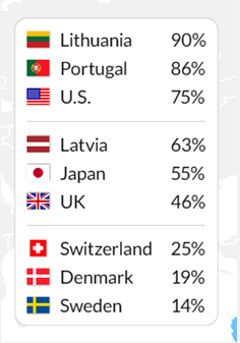
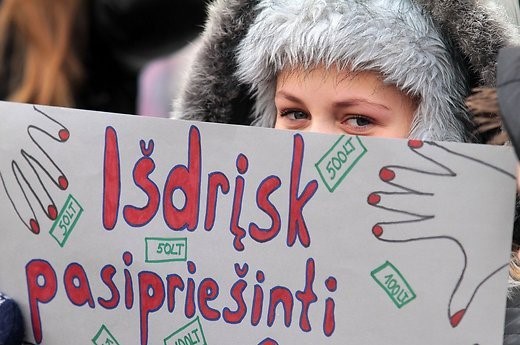


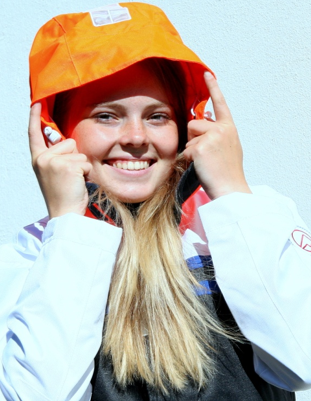



.jpg)
